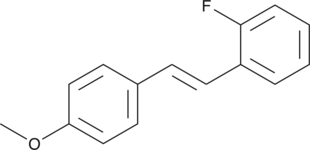Description
A carbamate pesticide; inhibits AChE activity and is toxic to the western flower thrip (F. occidentalis; IC50 = 2.1 μM; LC50 = 3.26 ppm); toxic to the land snail M. obstructa (LD50 = 27.4 μg/snail) and the citrus mite A. pelekassi; reduces the seasonal percentages of cotton bolls infested with pink bollworm (P. gossypiella) to 4% when applied to cotton fields at 1.86 lb/acre; reduces damage to grapes by song birds when applied to vineyards at 2.5 lbs AI per 100 gal water per acre; is an ERα and ERβ agonist (EC20s = 19.87 and 20.24 μM, respectively) and an androgen receptor antagonist (IC50 = 13.89 μM); toxic to juvenile rainbow trout (O. mykiss) and guppies (P. reticulata; LC50s = 0.8 and 1.48 mg/L, respectively)
Formal name: 3,5-dimethyl-4-(methylthio)-phenol, 1-(N-methylcarbamate)
Synonyms: 4-Methylthio-3,5-dimethylphenyl methylcarbamate|BAY 37344|Mercaptodimethur
Molecular weight: 225.3
CAS: 2032-65-7
Purity: ≥98%
Formulation: A crystalline solid
Product Type|Biochemicals|Pesticides|Acaricides||Product Type|Biochemicals|Pesticides|Insecticides||Product Type|Biochemicals|Receptor Pharmacology|Agonists||Product Type|Biochemicals|Receptor Pharmacology|Antagonists||Product Type|Biochemicals|Small Molecule Inhibitors|MMPs||Research Area|Cell Biology||Research Area|Endocrinology & Metabolism|Hormones & Receptors||Research Area|Endocrinology & Metabolism|Reproductive Biology||Research Area|Neuroscience||Research Area|Toxicology|Environmental|Agriculture||Research Area|Toxicology|Environmental|Aquatic Systems||Research Area|Toxicology|Environmental|Endocrine Disruption



